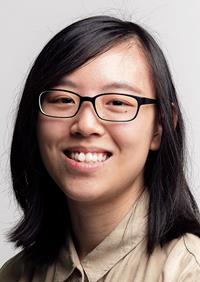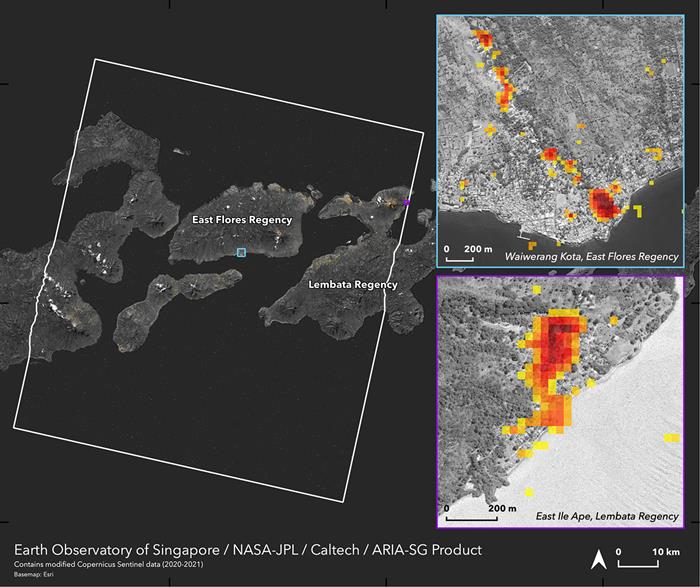In this interview series, we learn about the perspectives of the PhD students whose wide-ranging work contributes to the SEA2 Program and share what drives them in their research.
How often do disasters happen around the world?
"Every day," divulged Cheryl Tay, a first-year PhD student from the Earth Observatory of Singapore’s (EOS) newly launched Remote Sensing Lab. "Floods are the most common occurrence. Somewhere in the world, there is a flood each day."
 Prior to joining the PhD programme, Cheryl was involved in disaster response and worked with various types of disasters occurring across the globe, such as floods, earthquakes, tsunamis, typhoons and volcanic eruptions using remote sensing tools. This work involved tapping into satellite imagery to remotely discern what was happening at disaster sites and disseminating information to humanitarian aid organisations to support relief efforts on the ground.
Prior to joining the PhD programme, Cheryl was involved in disaster response and worked with various types of disasters occurring across the globe, such as floods, earthquakes, tsunamis, typhoons and volcanic eruptions using remote sensing tools. This work involved tapping into satellite imagery to remotely discern what was happening at disaster sites and disseminating information to humanitarian aid organisations to support relief efforts on the ground.
"We work with agencies to reach out to those who need information on a disaster in Asia, for example, we are part of a network called Sentinel Asia that informs us of disasters and connects us to ministries of member countries and disaster relief organisations."
Cheryl Tan, first-year PhD student at EOS (Source: EOS)
Her work in the past has utilised mostly interferometric synthetic aperture radar (InSAR) data, in which a satellite takes images via radar waves that are transmitted to the ground and then scattered back to the satellite.
This measures the distance between the satellite and the land, and when the images taken are juxtaposed, shows changes in the surface land height over time. "A difference of a few centimetres up to millimetres in land height changes can be picked up," Cheryl pointed out.
Perhaps the most exciting thing about remote sensing, however, is the rising accessibility of various imagery, including synthetic aperture radar (SAR) and light detection and ranging (LIDAR) data, which are increasingly available in recent times.

Members of the recently formed EOS Remote Sensing team, from left to right: Associate Professor Sang-Ho Yun, Ms Cheryl Tay, Ms Way Lin, Ms Shi Tong Chin (Source: Phuong Nguyen/Earth Observatory of Singapore)
"InSAR covers a wider area at great resolution and "sees" through clouds, while LIDAR covers a smaller area but with even higher resolution," Cheryl shared. "It is only recently that more global missions aimed at collecting SAR and LIDAR data have been launched, with their data free for all to use. It’s a good opportunity to combine them with the existing data and produce more robust measurements."
An Asian School of Environment (ASE) alumni, Cheryl is no stranger to the EOS-ASE community, and prior to embarking on her PhD program, she was a research assistant in Associate Professor Emma Hill’s Geodesy Group.
"During my stint as a research assistant, I worked on mapping floods and damages so people would know where these disasters are,” she elaborated. “Oftentimes in disasters, places get cut off (in terms of communication and access) and it becomes difficult to find out what’s happening there, which is why remote sensing can be very helpful."
"I found the work meaningful as the things I did were not just for (me to gain) knowledge but to make a difference on the ground. That’s why I decided to pursue a PhD focused on remote sensing applications."
"What excites me most about this work is learning more about what technology can do now,” she enthused. "It’s amazing how much you can see in a satellite image and quite inspiring to see what more you can do with it!"

Map showing the damage in East Nusa Tenggara, Indonesia, as caused by Cyclone Seroja which struck the region in April 2021. Light to significant damage (yellow to red) by the cyclone was identified using before-and-after radar images (Source: Cheryl Tay/Earth Observatory of Singapore)
So what might Cheryl’s research look like?
"I’ll be looking at using InSAR to measure land height changes which affect relative sea level," she shared. "We usually think of climate change as causes of relative sea-level rise, but at the same time, human activities can affect land height changes and worsen relative sea-level rise too."
One of the human activities that can exacerbate relative sea-level rise is land subsidence, where the land sinks and compacts as groundwater is extracted. This might make it seem like sea level is rising even more. "You might be sinking while the sea is rising," Cheryl explained.
Land subsidence may sometimes be difficult to measure with Global Navigation Satellite Systems (GNSS), which records land height at a single point. So InSAR data, which a wider coverage, can pick up on the smaller variations that might have been missed.
"One benefit of InSAR is its large footprint, so you could take large snapshots to detect any sinking areas which people may have not been previously aware of."
Complementing this study approach is a look at fine-tuning existing Digital Elevation Models (DEMs) with high-resolution LIDAR data.
"At the moment, many DEMs are not very accurate in cities," Cheryl detailed, "because there are high-rise buildings, vegetation, and so many objects popping up which makes it difficult to pick up the land heights accurately. I’m working on developing a technique that could improve existing DEMs."
"In the SEA2 Program, we are all working on different components, including land heights, to help make relative sea-level rise projections more accurate. And with land heights, the changes could range from regional to local scales, of which the latter is where my project fits into."
Last but not least, if there was a song to represent the key takeaway from this unfolding experience of the applications of remote sensing, what would it be?
"It would be 'Life Goes On' by BTS," replied the Korean pop music fan, "As many things may not go as planned, but I’m trying to always keep a positive outlook and go with the flow."